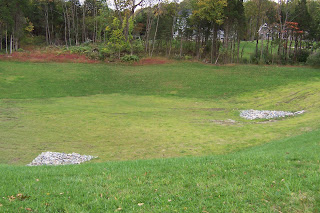Garden Design Ideas:
Formal design can display
symmetrical or asymmetrical balance
 | ||||
| Classic formal design at the Strickland Arms Bed and Breakfast, Austin, TX. |
Most people think of formal landscape design in terms of symmetrical balance. For example, in the first photo, at the Strickland Arms bed and breakfast in Austin, when you draw an imaginary line down the middle of the walk (the main axis), each side of the front yard is a mirror image of the other.
Symmetrical balance
Brick pavers in the foreground are laid exactly the same on either side of the central walkway. The yard is divided into equal-sized groundcover beds (drought parched the bed on the right), and further subdivided into equal-sized beds of grass as one approaches the house.
What isn't obvious from this photo is that horizontal paths (sub, or secondary-axes) further sub-divide the yard at about two-thirds of the way to the house and, again right before the porch steps. All of the paths are bordered on both sides by hundreds of Liriope. This is a simple example of a classic formal layout, in keeping with the style of the historic house.
Asymmetrical balance
Symmetrical balance
Brick pavers in the foreground are laid exactly the same on either side of the central walkway. The yard is divided into equal-sized groundcover beds (drought parched the bed on the right), and further subdivided into equal-sized beds of grass as one approaches the house.
What isn't obvious from this photo is that horizontal paths (sub, or secondary-axes) further sub-divide the yard at about two-thirds of the way to the house and, again right before the porch steps. All of the paths are bordered on both sides by hundreds of Liriope. This is a simple example of a classic formal layout, in keeping with the style of the historic house.
Asymmetrical balance
 |
| Asymmetric formal design at Ft. Worth Botanical Garden |
But formal design can also be asymmetrical, as demonstrated by this path in the Japanese Garden of the Fort Worth Botanical Garden, shown in the second photo. A random pattern of granite pieces set in concrete forms a central path (the main axis). On the left, Mondo Grass borders the path and is flanked by a bed of groundcover.
On the right side, the path is bordered by a soldier course of stones of irregular height, backed by a bed of turf grass. The shapes and sizes of both beds are different, while the path itself maintains a uniform width as it passes between them. When you draw an imaginary centerline down this path, the pattern is symmetrical: path, border, bed, but its treatment is not. The result is balanced, but asymmetrical.
On the right side, the path is bordered by a soldier course of stones of irregular height, backed by a bed of turf grass. The shapes and sizes of both beds are different, while the path itself maintains a uniform width as it passes between them. When you draw an imaginary centerline down this path, the pattern is symmetrical: path, border, bed, but its treatment is not. The result is balanced, but asymmetrical.

